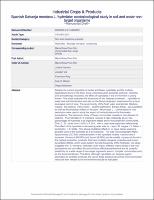Por favor, use este identificador para citar o enlazar este ítem:
https://repositorio.usj.es/handle/123456789/1092
| Título : | Spanish Satureja montana L. hydrolate: Ecotoxicological study in soil and water non-target organisms (Versión aceptada) |
| Autor: | Pino Otín, Rosa


Navarro, Juliana 


Val Pulido, Jonatan Roig, Francisco J. 

Mainar, Ana M. 


Ballestero Fernández, Diego |
| Palabras clave : | Microorganisms, soil ecotoxty; Biolog EcoPlates; Hydrolate Satureja montana; Ecotoxicity |
| Fecha de publicación: | 20-ene-2022 |
| Editorial : | Elsevier |
| Citación : | María Rosa Pino-Otín, Juliana Navarro, Jonatan Val, Francisco Roig, Ana M. Mainar, Diego Ballestero, Spanish Satureja montana L. hydrolate: Ecotoxicological study in soil and water non-target organisms, Industrial Crops and Products, Volume 178, 2022, 114553, ISSN 0926-6690, https://doi.org/10.1016/j.indcrop.2022.114553. (https://www.sciencedirect.com/science/article/pii/S092666902200036X) |
| Resumen : | Despite the current popularity of herbal and flower hydrolates and the multiple applications found in the food, wood, pharmaceutical, pesticide, perfume, cosmetic, and aromatherapy industries, the effect of hydrolates in the environment is poorly known. This study evaluates the ecotoxicity of the Satureja montana L. hydrolate on water and soil bioindicators and also on the fluvial periphyton mesocosms for a more ecological point of view. The acute toxicity of the fresh water invertebrate Daphnia magna, the bacteria Vibrio fisheri, and the earthworm Eisenia fetida, was quantified as well as the phytotoxic effect on the plant Allium cepa L. Communities of river periphyton were used to study the impact of the hydrolate on the freshwater ecosystems. The taxonomic study of these communities revealed a rich diversity of diatoms. The hydrolate of S. montana showed a high ecotoxicity at very low percentages of hydrolate in all organisms tested and in the periphyton communities. The LC50 varies from 0.05% to 4.25%, with a clear dose-dependent relationship. The effect of the hydrolate in decreasing order was: A.cepa > D. magna > V. fisheri > periphyton > E. fetida. The strong phytotoxic effect on A. cepa allows exploring possible uses of the hydrolate as a bio-herbicide. The Gas Chromatography Mass Spectrometry (GC-MS) characterisation of the hydrolate reveals 1 alcohol and 6 terpenes. Carvacrol (89.03%) and thymol (6.66%) are the volatile compounds found in the highest proportion, products that have multiple biological properties and known synergistic effects, which could explain the high bioactivity of the hydrolate. Our study suggests that S. montana hydrolate could impact different trophic levels of the river ecosystems and can affect the soil functions affecting earthworms due its powerful bioactivity on a wide range of non-target organisms even in complex communities such as the fluvial periphyton. Therefore, although hydrolates can become a good alternative to synthetic products, the use of these products is not free of environmental risks and their release to the environment should be evaluated |
| URI : | https://repositorio.usj.es/handle/123456789/1092 |
| ISSN : | 1872-633X |
| Aparece en las colecciones: | Artículos de revistas |
Ficheros en este ítem:
| Fichero | Descripción | Tamaño | Formato | |
|---|---|---|---|---|
| Spanish Satureja montana version aceptada.pdf | 2,86 MB | Adobe PDF |  Visualizar/Abrir |
Este ítem está sujeto a una licencia Creative Commons Licencia Creative Commons

